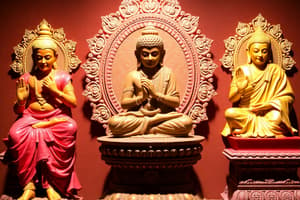Podcast
Questions and Answers
What was the primary motivation behind the reaction against ritualism in ancient India?
What was the primary motivation behind the reaction against ritualism in ancient India?
- To provide a more affordable alternative to the common people (correct)
- To encourage animal sacrifices
- To promote the dominance of Brahmins
- To establish a more rigid caste system
Which language was considered sacred in ancient India?
Which language was considered sacred in ancient India?
- Prakrit
- Pali
- Sanskrit (correct)
- Tamil
Who were the rulers of Magadha in the sixth century BC?
Who were the rulers of Magadha in the sixth century BC?
- Ashoka and Chandragupta
- Rama and Krishna
- Harsha and Shankara
- Bimbisara and Ajatashatru (correct)
What was the primary reason for the restrictions on social mobility in ancient India?
What was the primary reason for the restrictions on social mobility in ancient India?
What was the primary motivation behind the protests of Kshatriya rulers?
What was the primary motivation behind the protests of Kshatriya rulers?
What was the impact of the use of iron on agriculture in ancient India?
What was the impact of the use of iron on agriculture in ancient India?
What was the primary characteristic of the Vedic literature?
What was the primary characteristic of the Vedic literature?
What was the primary concern of farmers in the Gangetic Valley?
What was the primary concern of farmers in the Gangetic Valley?
What was the commonality between Jainism and Buddhism?
What was the commonality between Jainism and Buddhism?
What was the primary reason for the corruption in religion in ancient India?
What was the primary reason for the corruption in religion in ancient India?
Flashcards are hidden until you start studying
Study Notes
Factors Contributing to the Rise of Jainism and Buddhism
Reaction against Ritualism
- Religious ceremonies became very expensive, making them inaccessible to ordinary people
- Priests were detached from the sufferings of common people, leading to a demand for simpler and less expensive faiths
Political Climate
- Magadha was ruled by Bimbisara and Ajatashatru, who were not influenced by Brahmanism and condemned social evils
- These rulers patronized Jainism and Buddhism when the opportunity arose
Rigid Caste System
- Indian society was divided into four rigid Varnas: Brahmins, Kshatriyas, Vaishyas, and Shudras
- No social mobility was allowed, and caste restrictions were in place
- Interchange of caste was impossible
Language Barrier
- Vedic literature was composed in Sanskrit, considered a sacred language
- Priests used Sanskrit, which was difficult for common people to understand
- This led to a search for alternative religions that could be understood better
Corruption in Religion
- Priests practiced corruption, encouraging people to perform Yajnas and conduct household rites beyond their means
- Kshatriya rulers protested against the dominance of such practices
- Common people rejected the priests' attitude
Agricultural Economy
- In the Gangetic Valley, animal sacrifices were against the interests of farmers
- The use of iron had made animal-drawn ploughing popular
- Farmers needed a religion that protected their animals
- Jainism and Buddhism preached non-violence and opposed animal sacrifices
Studying That Suits You
Use AI to generate personalized quizzes and flashcards to suit your learning preferences.




